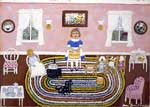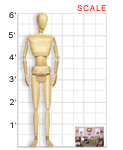VAM galleries including this work:
Behringer-Crawford Museum | Young at Art || VAM Home
Mary Bruce Sharon (American, 1877-1961)
MY DOLL’S WASHTUB, c. 1950s
Gouache on cardboard; 10" X 14"
From the Eva G. Farris Collection of the Behringer-Crawford Museum
Mary Bruce Sharon had this to say about My Doll’s Washtub, which depicts a scene from 1883:
This is a picture of me in my playroom. Mama had it decorated pink, my favorite color. The pictures were all scenes from nursery rhymes. My favorite toys were the washtub and stove. I washed my doll clothes in the tub, hung them out to dry, and ironed them. The stove was real, and I cooked on it. I served meals to my dolls, and I also invited Mama and Grandpa to come to tea. My little black spaniel, Tilly, enjoyed everything I served her. I was a very domestic child, and cooking has always been one of my favorite pursuits.
About the Artist
Mary Bruce Sharon moved to Covington, Kentucky after the death of her father in 1880. Under the care of her wealthy grandfather, Col. Henry Bruce (a Confederate sympathizer and businessman who helped hire John Roebling to design and build the famous suspension bridge that crosses the Ohio River between Covington and Cincinnati), she led a privileged life there. She had her own playroom equipped with working appliances; met famous people like Sitting Bull, Tom Thumb, and Buffalo Bill; and traveled with her family to New York City for part of each year. Mary visited the Metropolitan Museum of Art for the first time when she was 7. Both her mother and grandfather collected art.
 Another painting by Mary Bruce Sharon showing herself as a child with one of her dolls, also from the Behringer-Crawford Museum collection.
Another painting by Mary Bruce Sharon showing herself as a child with one of her dolls, also from the Behringer-Crawford Museum collection.
Mary wed Fredrick Christy Sharon, and the couple spent the early years of their marriage in Kansas City. They had one child, Henrietta. The Sharons moved to New York in 1939 and then to Connecticut. After her husband died in 1944, Mary went to live with her daughter.
At the age of 71, Sharon (known as “Mouse” to her friends) took up painting at the suggestion of her son-in-law, abstract painter Carroll Aument. She continued until her death in 1961, completing 150 paintings in 13 years. She worked mostly in gouache—a heavy, opaque watercolor paint that produces a drier-looking and more strongly colored result than ordinary watercolor.
Most of Sharon’s paintings depict scenes from her early childhood. Her artwork was influenced by such themes as her childhood in Covington, the Ohio and Licking rivers, and the Kentucky Derby. The clothing, architecture, and furnishings she painted offer a glimpse into the world of a wealthy child in the late 1800s, including popular activities and family traditions. Sharon also painted scenes of New York City as well as others inspired by stories from her grandfather’s and great-grandparents’ lives.
Sharon’s paintings were exhibited at the Taft Museum in Cincinnati and at the Metropolitan Museum of Art in New York City. Her works also have been included in a Smithsonian Institution traveling exhibit and in a book she wrote, Scenes from Childhood.
Classroom Ideas
Discussion: If you looked at this painting without knowing who the artist was, would you think it had been painted by an adult or a child? Why? What is the first thing you notice when you look at this picture? What is the little girl doing? What things are in her room? What does the painting tell us about her? What color is used most? What is your favorite color? Why?
Activities: Paint yourself playing with one of your favorite childhood toys.
Create a painting using your favorite color as the main color.



